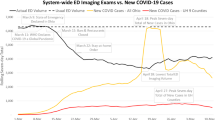Abstract
We sought to determine if CT utilization rates varied by characteristics of the physician. A chart review was performed at an urban academic emergency department (ED) to identify all the CT scans ordered and patients seen for subjects 21 years of age and older by physicians between January 2001 and December 2008. “Years of experience” was defined as years of practice after residency. Various experience cutoffs were determined a priori. Physicians were labeled “academic” if they had reduced clinical hours for academic duties and “clinical” if they were physicians without “protected time.” We categorized physicians as “high users” (top quartiles) and “low users” (bottom quartiles), and compared utilization rates from 2001 to 2003 to utilization rates from 2005 to 2007. There were 280 physician-years of practice, with an average experience of 6.1 years. When comparing groups of physicians with more or less than 3, 5, 10, and 15 years of experience, there were no statistically significant differences between the number of CT scans per 1,000 visits (p = 0.85; p = 0.21; p = 0.57; p = 0.08, respectively). Comparison between clinical and academic physicians yielded no differences (clinical = 98.4, academic = 104.2, p = 0.10). Low users ordered 78 CT scans per 1,000 patient visits (95 % CI 76.6–78.5), as compared to the high users that ordered 135 CT scans per 1,000 patient visits (95 % CI 131.8–139.0). We found that all of physicians stayed within their quartiles except one. While there was substantial variation among CT utilization rates by physicians at this urban emergency department, our data shows no differences between physicians with more or less clinical experience and no change in individual utilization patterns during the study period.

Similar content being viewed by others
References
Brenner DJ, Hall EJ (2007) Computed tomography—an increasing source of radiation exposure. N Engl J Med 357:2277–2284
Broder J, Warshauer DM (2006) Increasing utilization of computed tomography in the adult emergency department, 2000-2005. Emerg Radiol 13:25–30
Lee J, Kirschner J, Pawa S, Wiener DE, Newman DH, Shah K (2010) Computed tomography use in the adult emergency department of an academic urban hospital from 2001 to 2007. Ann Emerg Med 56:591–596
Kirsch TD, Hsieh YH, Horana L, Holtzclaw SG, Silverman M, Chanmugam A (2011) Computed tomography scan utilization in emergency departments: a multi-state analysis. J Emerg Med 41(3):302–309. doi:10.1016/j.jemermed.2010.06.030
Korley FK, Pham JC, Kirsch TD (2010) Use of advanced radiology during visits to US emergency departments for injury-related conditions, 1998-2007. JAMA: J Am Med Assoc 304:1465–1471
Brenner D, Elliston C, Hall E, Berdon W (2001) Estimated risks of radiation-induced fatal cancer from pediatric CT. AJR Am J Roentgenol 176:289–296
Shah KH, Slovis BH, Runde D, Godbout B, Newman DH, Lee J (2013) Radiation exposure among patients with the highest CT scan utilization in the emergency department. Emerg Radiol 20:485–491
Stiell IG, Clement CM, Rowe BH et al (2005) Comparison of the Canadian CT Head Rule and the New Orleans Criteria in patients with minor head injury. JAMA: J Am Med Assoc 294:1511–1518
Eagles D, Stiell IG, Clement CM et al (2008) International survey of emergency physicians’ awareness and use of the Canadian Cervical-Spine Rule and the Canadian Computed Tomography Head Rule. Acad Emerg Med: Off J Soc Acad Emerg Med 15:1256–1261
Donohoo JH, Mayo-Smith WW, Pezzullo JA, Egglin TK (2008) Utilization patterns and diagnostic yield of 3421 consecutive multidetector row computed tomography pulmonary angiograms in a busy emergency department. J Comput Assist Tomogr 32:421–425
Conflict of interest
The authors declare that they have no conflict of interest.
Author information
Authors and Affiliations
Corresponding author
Additional information
No support was provided in the form of equipment, drugs, or grants.
This article has not been previously presented.
Rights and permissions
About this article
Cite this article
Kirschner, J., Shah, K., Runde, D. et al. Patterns in computed tomography utilization among emergency physicians in an urban, academic emergency department. Emerg Radiol 21, 577–581 (2014). https://doi.org/10.1007/s10140-014-1237-x
Received:
Accepted:
Published:
Issue Date:
DOI: https://doi.org/10.1007/s10140-014-1237-x




